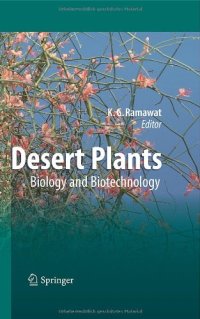
Ebook: Desert Plants: Biology and Biotechnology
- Genre: Biology // Biotechnology
- Tags: Plant Physiology, Plant Breeding/Biotechnology, Plant Anatomy/Development, Agriculture, Plant Ecology, Nature Conservation
- Year: 2010
- Publisher: Springer-Verlag Berlin Heidelberg
- Edition: 1
- Language: English
- pdf
Deserts appear very fascinating during our short visits. However, the lives of plants and animals are very dif?cult under the harsh climatic conditions of high tempe- ture and scant water supply in deserts, sometimes associated with high concent- tions of salt. The editor of this book was born and brought up in the Great Indian Desert, and has spent much of his life studying the growth and metabolism of desert plants. It is very charming on a cool summer evening to sit at the top of a sand dune listening only to blowing air and nothing else. It has been my dream to prepare a volume on desert plants encompassing various aspects of desert plant biology. In this book, I have tried to present functional and useful aspects of the vegetation resources of deserts along with scienti?c input aimed at understanding and impr- ing the utility of these plants. The scant vegetation of deserts supports animal life and provides many useful medicines, timber and fuel wood for humans. Therefore, there are chapters devoted to medicinal plants (Chap. 1), halophytes (Chaps. 13, 14), and fruit plants (Chaps. 17, 20). Desert plants have a unique reproductive biology (Chaps. 9–11), well-adapted eco-physiological and anatomical charact- istics (Chap. 7), and specialised metabolism and survival abilities. These plants are dif?cult to propagate and pose many problems to researchers developing biote- nological approaches for their amelioration (Chaps. 18–20).
Vast areas of Earth's landmass exist as deserts, representing quite distinct ecosystems. Desert plants and animals have evolved specialised survival strategies to cope with the harsh environment of high temperatures and scarce water resources. The life-supporting vegetation of deserts is characterised by its unique reproductive biology, metabolism and adaptive characters. Plants like Prosopis cineraria and date palm form the basis of the rural economy in many countries, and are of great cultural importance; Jojoba and Jatropha have attracted interest as non-conventional sources of industrial oil and biodiesel. This book includes chapters on the seed biology, reproduction, mycorrhizae, stress physiology, and metabolism of desert plants, and describes current biotechnological approaches to their cultivation. It will be useful to researchers, teachers and students in the fields of plant sciences, agriculture, and forestry, and those involved in the management and conservation of desert ecosystems.